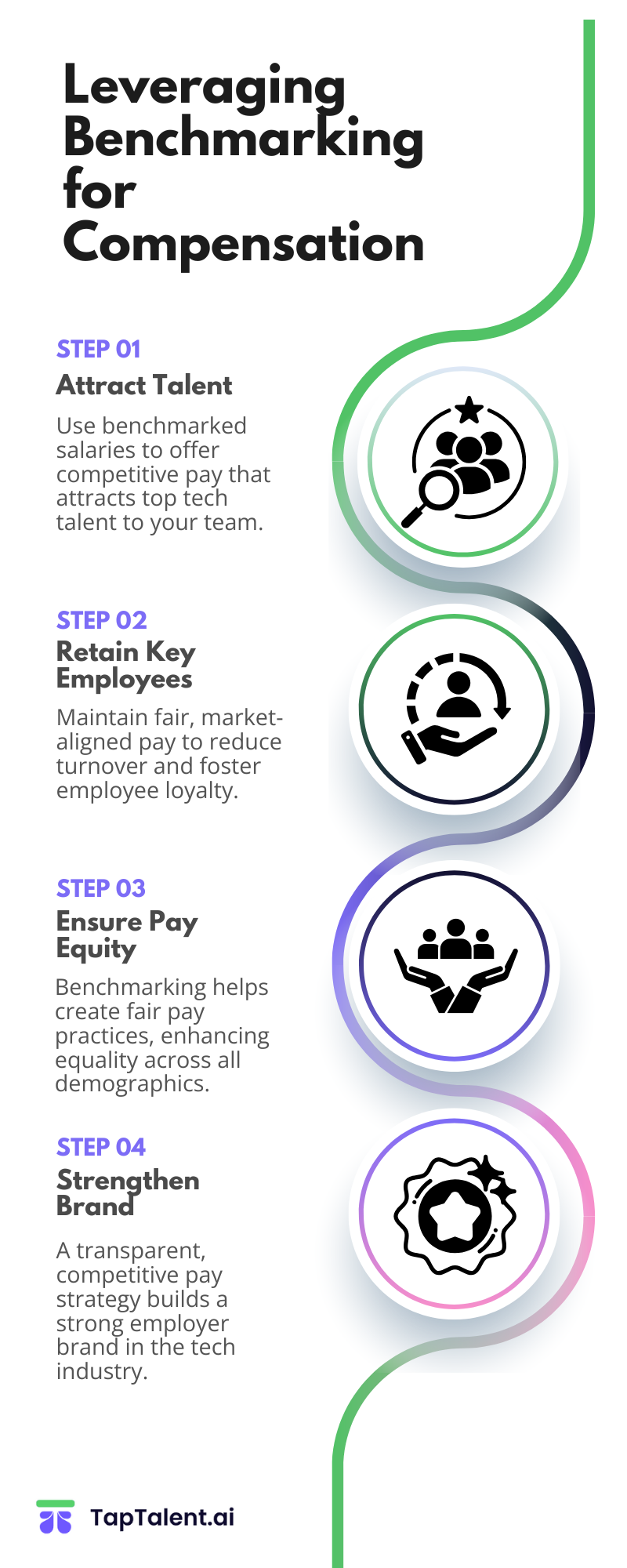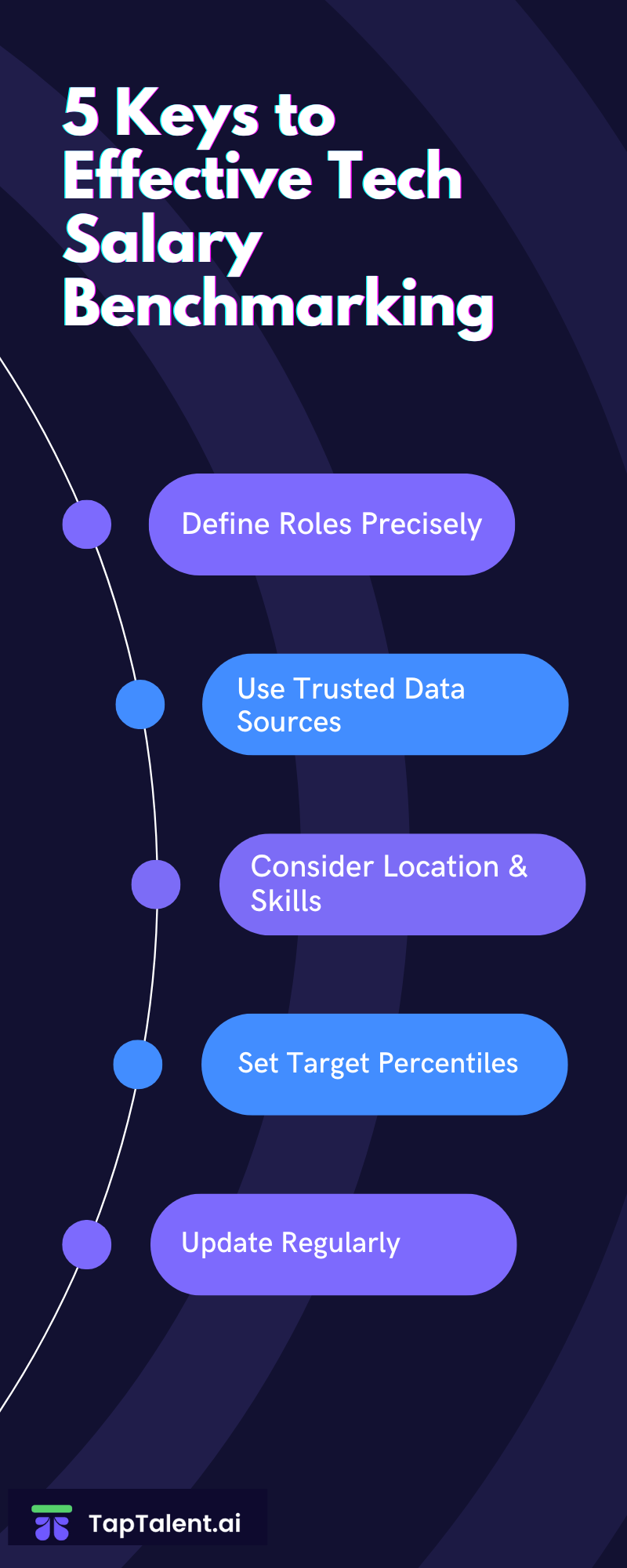In an era where tech titans are waging a talent war, setting the right salary can be the difference between thriving and merely surviving. A recent survey highlights that a significant percentage of tech companies fail to attract top talent due to uncompetitive pay. This blog post delves into the crucial realm of tech salary benchmarking, a strategic approach that equips companies with the insight to offer competitive compensation in a rapidly evolving industry. By leveraging tech salary benchmarks, organizations can overcome the challenges of establishing fair and appealing salaries amidst industry flux.
We will guide you through the essentials of salary benchmarking, elucidating its significance and how it can be harnessed to create compelling compensation packages. Starting with a foundational understanding of what salary benchmarking entails, we will explore the different methods and reliable data sources vital for making informed pay decisions. The step-by-step guide will equip you with knowledge on defining roles, analyzing data, setting salary ranges, and ensuring regular updates to your compensation strategies. Finally, discover how strategic compensation using tech salary benchmarks can attract and retain top talent. Dive into the following sections to understand how to position your organization as a leader in the tech market with data-driven salary decisions.
Understanding Tech Salary Benchmarking: A Data-Driven Approach
Tech salary benchmarking serves as a pivotal practice for companies aiming to stay competitive in the bustling tech landscape. So, what exactly is salary benchmarking? At its core, salary benchmarking involves comparing a company’s compensation packages against industry standards to ensure offerings remain appealing to top talent. This process not only helps organizations set fair salaries but also aids in making informed pay decisions based on data-driven insights.
First and foremost, let’s consider key factors that significantly influence tech salaries:
- Location: Geographical differences can greatly impact salary figures. For example, a tech position in Silicon Valley typically commands higher pay than the same position in rural regions due to the cost of living and talent competition.
- Skills and Experience: Specialized skills, such as proficiency in AI or cloud computing, often lead to premium pay. Including skill-based pay structures ensures your company attracts skilled professionals crucial for technological advancement.
Emphasizing these factors, companies can then explore various approaches to benchmarking:
- Internal Benchmarking: Involves analyzing salary data within the organization to maintain pay equity and fairness.
- External Benchmarking: Examines compensation norms across the industry, utilizing data from salary surveys, market research, and industry reports.
- Hybrid Benchmarking: Combines both internal and external data for a well-rounded perspective, which often provides the most comprehensive salary framework.
Robust and reliable data sources are essential for effective benchmarking. Companies should turn to reputable industry reports like the Robert Half Technology Salary Guide or the Bureau of Labor Statistics for accurate and up-to-date information. These resources help ensure that compensation strategies are aligned with current market standards, thus enhancing an organization’s attractiveness to potential hires.
To illustrate the significance of data-driven salary decisions, consider a case where Company A, an emerging tech firm, implemented strategic salary benchmarking. By leveraging external data and market insights, they adjusted their salary packages, resulting in a 25% increase in their hiring success rate over one year, alongside improved retention rates.

Conducting Effective Tech Salary Benchmarking: A Step-by-Step Guide
With a solid understanding of tech salary benchmarking and its importance, it’s time to dive into the process of effectively conducting salary benchmarking. This step-by-step guide will provide you with the practical knowledge needed to establish fair and competitive compensation structures that attract and retain top talent.
Step 1: Define Roles and Responsibilities
The initial step in tech salary benchmarking is establishing clear job descriptions. Precise definitions of roles and responsibilities are crucial as they lay the groundwork for fair compensation. Without this clarity, determining the appropriate salary ranges becomes a guessing game, which can result in overpaying or underpaying your employees.
Imagine constructing a house with ambiguous blueprints—eventually, the whole structure will be unstable. Similarly, unclear job roles can lead to compensation imbalances. Therefore, align job descriptions with industry standards and the specific needs of your organization.
Step 2: Gather and Analyze Data
Once roles are well-defined, gather data that corresponds to these roles. This data can come from various sources, including salary surveys, industry reports, and online salary databases. Use tools like Payscale or Glassdoor to collect market data efficiently.
Next, analyze the collected data to identify trends and anomalies. Look for patterns in pay rates across similar roles and pinpoint the variables affecting these rates. For instance, roles involving cutting-edge technologies like AI might command different salaries depending on geographical location and company size.
Step 3: Determine Target Percentiles
The third step involves setting target salary percentiles, an approach that helps companies decide how competitive their salaries should be. Choosing between the 50th to 75th percentiles is standard practice but can be adjusted based on strategic objectives.
For a startup aiming to compete aggressively for talent, setting salaries at the 75th percentile might be necessary. In contrast, established firms may focus on the 50th percentile, leveraging other benefits to enhance compensation packages, such as flexible working hours or stock options.
Step 4: Develop Salary Ranges and Bands
With the target percentiles in place, convert your findings into visible salary structures. Developing salary ranges and bands provides flexibility and ensures pay equity by offering a range within which salaries can fall based on experience, skills, and performance.
For example, if your target for a software engineer is $80,000 at the 50th percentile, establish a range from $70,000 to $90,000. This band allows for variations due to factors such as skill level and market dynamics while maintaining a clear framework.
Step 5: Regular Review and Updates
The tech landscape evolves rapidly; hence your compensation strategy needs to keep pace. Regularly review and update salary benchmarks to reflect changes in the market and maintain competitiveness.
Consider conducting semi-annual or annual reviews, integrating recent data, and adjusting salary bands as required. This ongoing process not only ensures that your salaries remain competitive but also signals to current and potential employees that your organization is responsive and fair.
As we transition to the next section, we will explore how leveraging tech salary benchmarks can transform your compensation strategy into a strategic tool for attracting and retaining top-tier talent. By adopting a calculated and informed approach to salary benchmarking, your organization can confidently navigate the intricacies of tech pay scales, staying ahead in the talent race.

Leveraging Tech Salary Benchmarks for Strategic Compensation
In the tech industry, attracting and retaining top talent is as much an art as it is a science. Transitioning from the fundamentals of gathering and analyzing salary data, as we discussed in the previous section, let’s explore how leveraging tech salary benchmarks can transform your compensation strategy into a strategic asset.
Attracting Top Talent
To recruit the best in tech, your compensation packages must stand out. Competitive salaries play a pivotal role, serving as a powerful magnet for candidates. By implementing tech salary benchmarks, organizations gain insights into current salary trends, allowing them to offer compensation that meets or exceeds industry standards. For instance, a company in an emerging tech hub offering salaries aligned with those in more established tech centers can attract talent unwilling to relocate.
Moreover, incorporating additional benefits such as stock options, flexible work schedules, and professional development opportunities can amplify this appeal. When candidates compare offers, these enhancements often tip the scale in your favor, demonstrating a commitment not just to compensation but also to the holistic well-being of your employees.
Retaining Employees
Beyond attracting top-tier talent, maintaining a competitive compensation strategy is vital for employee retention. Excessive turnover can destabilize a company, disrupting team dynamics and slowing innovation. By regularly benchmarking salaries, you identify and rectify discrepancies that may cause dissatisfaction and turnover.
Consider the case of TechCorp, which experienced a 15% increase in employee retention after revising their compensation strategy based on thorough benchmarking. Employees felt valued and respected, knowing their salaries reflected both their individual contributions and market trends. This approach underscores the importance of viewing salary benchmarking not as a static task but as an ongoing process that evolves with market conditions.
Building a Strong Employer Brand
A strategic compensation strategy also plays an integral role in shaping your employer brand. When salary ranges are transparent and competitive, they enhance your company’s reputation as a fair and appealing workplace. This reputation can be further bolstered by actively promoting the benefits of working for your company, such as work-life balance initiatives and career growth opportunities.
For example, when Glassdoor reviews feature positive remarks about a company’s competitive compensation packages and workplace culture, they strengthen the company’s employer brand. Such feedback not only attracts new applicants but also boosts current, satisfied employees’ morale and advocacy.
Addressing Pay Equity
Ensuring fair compensation across demographics is a critical aspect of leveraging tech salary benchmarks. Pay equity reflects a company’s commitment to fairness and inclusivity, fostering an environment where diversity thrives. Utilizing benchmarking data, companies can identify and close wage gaps, reinforcing their dedication to equitable pay practices.
Implementing regular salary audits can be an effective strategy. These audits compare salaries across departments and demographic groups, revealing disparities and guiding corrective actions. By addressing pay inequities, organizations build trust with employees, promoting higher engagement and productivity.
As we transition to exploring tools and technologies for tech salary benchmarking in the next section, it’s clear that by adopting a comprehensive benchmarking strategy, your organization can craft a compelling compensation framework. This framework not only attracts and retains top talent but also enhances your employer brand and ensures pay equity, positioning your organization as a leader in the tech market.

Tools and Technologies for Tech Salary Benchmarking
To ensure your salary benchmarking efforts remain precise and up-to-date in the ever-evolving tech landscape, leveraging the right tools and technologies is crucial. As we transition from analyzing strategic compensation strategies, these tools serve as the backbone for data management, analysis, and visualization—all essential components for making informed decisions.
Software Solutions
A variety of software solutions are available to streamline the salary benchmarking process. These tools automate data collection and analysis, reducing the risk of human error and saving significant time. For example, tools like Payscale, CompAnalyst, and PayFactors provide comprehensive insights into salary structures based on the latest market data. They allow you to customize reports and filter data based on specific criteria, ensuring that the insights gained are directly applicable to your organization’s needs.
Choosing the right software depends on your company’s size and specific requirements. Consider starting with a solution that offers scalability, enabling you to adapt as your company grows and your needs evolve.
Data Visualization
Data visualization tools enhance the interpretation of complex salary data, making trends and insights more accessible to decision-makers. Platforms like Tableau and Power BI offer robust visualization capabilities, transforming raw data into actionable insights through graphs, charts, and dashboards. These visual tools enable HR managers and executives to easily grasp salary trends and disparities, facilitating informed discussions and strategy development.
Visual metaphors, such as graphs illustrating salary distributions like a mountain range, help in visual connection, making complex information relatable and easier to digest. Such clarity empowers swift, confident decisions that align with your organization’s strategic goals.
Integration with HR Systems
To maximize the utility of salary benchmarking efforts, integration with existing HR systems is vital. Many benchmarking tools seamlessly connect with HR Management Systems (HRMS), such as Workday or SAP SuccessFactors. This integration ensures a flow of real-time data, allowing for continuous updates and adjustments to compensation plans in line with market trends.
Integrating benchmarking tools with HR systems also facilitates comprehensive employee audits, ensuring not only competitive salaries but also that pay equity is maintained across all demographics. This approach promotes fairness and transparency, reinforcing company values and strengthening employer branding.
Practical Tips and Future Implications
To remain competitive, it’s critical to regularly reassess the fit and functionality of your digital tools as market and organizational needs evolve. Here are a few actionable tips to get started:
- Regular Updates: Ensure the tools and technologies used are updated regularly to incorporate the latest salary data and industry trends.
- Metrics Alignment: Align the key metrics tracked in these tools with your strategic compensation goals to ensure clarity and direction.
- Training Programs: Invest in training HR teams to effectively use and interpret data from these tools, transforming raw information into strategic insights.
As the tech industry shifts towards more remote work arrangements, salary benchmarking tools are adapting by including geographical differentials. Future advancements in AI and machine learning will likely enhance these tools, providing predictive analytics to preemptively address compensation challenges.
In summary, leveraging the right tools and technologies in tech salary benchmarking equips your organization with a dynamic, informed approach to compensation strategy. By integrating these tools into your HR processes, you not only ensure competitive and fair salaries but also prepare your company to navigate future market changes effectively. As you strive to position your company as an industry leader, remember that successful salary benchmarking is both an art and a science, continually evolving with advancements in technology




